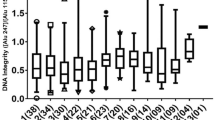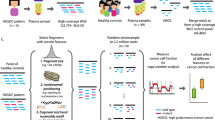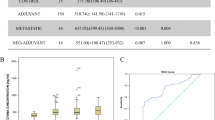Abstract
Purpose
Non-invasive blood-based molecular markers have been investigated for cancer diagnosis and prognosis. Circulating free or cell-free DNA (cfDNA) variables have been shown to be putative markers in breast cancer prognosis.
Methods
Here, we investigated the potential prognostic ability of cfDNA concentration and cfDNA integrity (cfDI) in a study cohort of 268 patients by quantitative PCR. We compared cfDNA concentration and cfDI at baseline and after one cycle of therapy in metastatic breast cancer (MBC) patients.
Results
A significantly increased cfDI (P = 1.21E-7 for ALU and P = 1.87E-3 for LINE1) and decreased cfDNA concentration (P = 1.17E-3 for ALU and P = 1.60E-2 for LINE1) in both repetitive DNA elements after one cycle of therapy was observed. A multiple Cox regression model indicated that cfDI and cfDNA concentration can serve as independent prognostic markers in patients at baseline with HR (95% CI) of 0.70 (0.48–1.01) for ALU cfDI, 0.63 (0.44–0.92) for LINE1 cfDI, 2.44 (1.68–3.53) for ALU cfDNA concentration, and 2.12 (1.47–3.06) for LINE1 cfDNA concentration and after one cycle of therapy with HR (95% CI) of 0.59 (0.42–0.84) for ALU cfDI, 0.51 (0.36–0.74) for LINE1 cfDI, 1.59 (1.31–1.92) for ALU cfDNA concentration, and 1.30 (1.17–1.45) for LINE1 cfDNA concentration, respectively. By comparing integrated prediction error of different models, cfDNA variables were shown to improve the prognostic power of the CTC status.
Conclusions
We hereby show that cfDNA variables, especially in combination with other markers, can serve as attractive prognostic markers for MBC patients at baseline and during the systematic therapy.



Similar content being viewed by others
Abbreviations
- AUC:
-
Area under the curve
- BL:
-
Baseline
- cfDI:
-
Circulating free or cell-free DNA integrity
- cfDNA:
-
Circulating free or cell-free DNA
- CI:
-
Confidence interval
- CTC:
-
Circulating tumor cell
- HR:
-
Hazard ratio
- IPE:
-
Integrated prediction errors
- MBC:
-
Metastatic breast cancer
- NCT:
-
National Center for Tumor Diseases, Heidelberg, Germany
- PFS:
-
Progression-free survival
- OS:
-
Overall survival
References
Siegel RL et al (2016) Cancer statistics, 2016. CA Cancer J Clin 66:7–30
Weigelt B et al (2005) Breast cancer metastasis: markers and models. Nat Rev Cancer 5:591–602
Mehlen P et al (2006) Metastasis: a question of life or death. Nat Rev Cancer 6:449–458
Swain SM et al (2015) Pertuzumab, trastuzumab, and docetaxel in HER2-positive metastatic breast cancer. N Engl J Med 372:724–734
Walker AJ et al (2016) FDA approval of palbociclib in combination with fulvestrant for the treatment of hormone receptor-positive, HER2-negative metastatic breast cancer. Clin Cancer Res 22:4968
Schwarzenbach H et al (2011) Cell-free nucleic acids as biomarkers in cancer patients. Nat Rev Cancer 11:426–437
Cuk K et al (2013) Circulating microRNAs in plasma as early detection markers for breast cancer. Int J Cancer 132:1602–1612
Madhavan D et al (2013) Cancer diagnosis and prognosis decoded by blood-based circulating microRNA signatures. Front Genet 4:116
Cuk K et al (2013) Plasma microRNA panel for minimally invasive detection of breast cancer. PLoS ONE 8:e76729
Madhavan D et al (2016) Circulating miRNAs with prognostic value in metastatic breast cancer and for early detection of metastasis. Carcinogenesis 37:461–470
Madhavan D et al (2012) Circulating miRNAs as surrogate markers for circulating tumor cells and prognostic markers in metastatic breast cancer. Clin Cancer Res 18:5972–5982
Madhavan D et al (2014) Plasma DNA integrity as a biomarker for primary and metastatic breast cancer and potential marker for early diagnosis. Breast Cancer Res Treat 146:163–174
Wallwiener M et al (2014) Serial enumeration of circulating tumor cells predicts treatment response and prognosis in metastatic breast cancer: a prospective study in 393 patients. BMC Cancer 14:512
Dawson SJ et al (2013) Analysis of circulating tumor DNA to monitor metastatic breast cancer. N Engl J Med 368:1199–1209
Cheng J et al (2017) Cell-free circulating DNA integrity is an independent predictor of impending breast cancer recurrence. Oncotarget 8:54537
Schwarzenbach H et al (2011) Cell-free nucleic acids as biomarkers in cancer patients. Nat Rev Cancer 11:426–437
Diaz LA Jr et al (2014) Liquid biopsies: genotyping circulating tumor DNA. J Clin Oncol 32:579–586
Hao TB et al (2014) Circulating cell-free DNA in serum as a biomarker for diagnosis and prognostic prediction of colorectal cancer. Br J Cancer 111:1482–1489
Szpechcinski A et al (2015) Cell-free DNA levels in plasma of patients with non-small-cell lung cancer and inflammatory lung disease. Br J Cancer 113:476–483
Huang ZH et al (2006) Quantitative analysis of plasma circulating DNA at diagnosis and during follow-up of breast cancer patients. Cancer Lett 243:64–70
Jiang WW et al (2006) Increased plasma DNA integrity index in head and neck cancer patients. Int J Cancer 119:2673–2676
Wang BG et al (2003) Increased plasma DNA integrity in cancer patients. Cancer Res 63:3966–3968
El-Shazly SF et al (2010) Evaluation of serum DNA integrity as a screening and prognostic tool in patients with hepatitis C virus-related hepatocellular carcinoma. Int J Biol Markers 25:79–86
Stötzer OJ et al (2014) Diagnostic relevance of plasma DNA and DNA integrity for breast cancer. Tumor Biol 35:1183–1191
McShane LM et al (2005) REporting recommendations for tumour MARKer prognostic studies (REMARK). Br J Cancer 93:387–391
Riethdorf S et al (2007) Detection of circulating tumor cells in peripheral blood of patients with metastatic breast cancer: a validation study of the cell search system. Clin Cancer Res 13:920–928
Wallwiener M et al (2015) The impact of HER2 phenotype of circulating tumor cells in metastatic breast cancer: a retrospective study in 107 patients. BMC Cancer 15:403
Cristofanilli M et al (2005) Circulating tumor cells: a novel prognostic factor for newly diagnosed metastatic breast cancer. J Clin Oncol 23:1420–1430
Leon SA et al (1977) Free DNA in the serum of cancer patients and the effect of therapy. Cancer Res 37:646–650
Deligezer U et al (2008) Effect of adjuvant chemotherapy on integrity of free serum DNA in patients with breast cancer. Ann N Y Acad Sci 1137:175–179
Cheng J et al. (2017) Cell-free circulating DNA Integrity based on peripheral blood as a biomarker for diagnosis of cancer: a systematic review. Cancer Epidemiol Biomark
Mead R et al (2011) Circulating tumour markers can define patients with normal colons, benign polyps, and cancers. Br J Cancer 105:239–245
Huang A et al (2016) Plasma circulating cell-free DNA integrity as a promising biomarker for diagnosis and surveillance in patients with hepatocellular carcinoma. J Cancer 7:1798–1803
Umetani N et al (2006) Prediction of breast tumor progression by integrity of free circulating DNA in serum. J Clin Oncol 24:4270–4276
Jahr S et al (2001) DNA fragments in the blood plasma of cancer patients: quantitations and evidence for their origin from apoptotic and necrotic cells. Cancer Res 61:1659–1665
Heitzer E et al (2015) Circulating tumor DNA as a liquid biopsy for cancer. Clin Chem 61:112–123
Underhill HR et al (2016) Fragment Length of Circulating Tumor DNA. PLoS Genet 12:e1006162
Jiang P et al (2015) Lengthening and shortening of plasma DNA in hepatocellular carcinoma patients. Proc Natl Acad Sci USA 112:E1317–E1325
Atamaniuk J et al (2004) Increased concentrations of cell-free plasma DNA after exhaustive exercise. Clin Chem 50:1668–1670
van der Vaart M et al (2007) The origin of circulating free DNA. Clin Chem 53:2215
Umetani N et al (2006) Prediction of breast tumor progression by integrity of free circulating DNA in serum. J Clin Oncol 24:4270–4276
Chandarlapaty S et al (2016) Prevalence of ESR1 Mutations in Cell-Free DNA and Outcomes in Metastatic Breast Cancer: a secondary analysis of the BOLERO-2 clinical trial. JAMA Oncol 2:1310–1315
Budd GT et al (2006) Circulating tumor cells versus imaging—predicting overall survival in metastatic breast cancer. Clin Cancer Res 12:6403
Kronek L-P et al (2008) Logical analysis of survival data: prognostic survival models by detecting high-degree interactions in right-censored data. Bioinformatics 24:i248–i253
El Messaoudi S et al (2013) Circulating cell free DNA: preanalytical considerations. Clin Chim Acta 424:222–230
Acknowledgements
We thank the study participants and all our colleagues who helped us with patient recruitment, blood collection, and processing. The study has been supported by cellgene.
Author information
Authors and Affiliations
Corresponding author
Ethics declarations
Conflict of interest
The authors declare that they have no conflict of interest.
Electronic supplementary material
Below is the link to the electronic supplementary material.
Rights and permissions
About this article
Cite this article
Cheng, J., Holland-Letz, T., Wallwiener, M. et al. Circulating free DNA integrity and concentration as independent prognostic markers in metastatic breast cancer. Breast Cancer Res Treat 169, 69–82 (2018). https://doi.org/10.1007/s10549-018-4666-5
Received:
Accepted:
Published:
Issue Date:
DOI: https://doi.org/10.1007/s10549-018-4666-5




